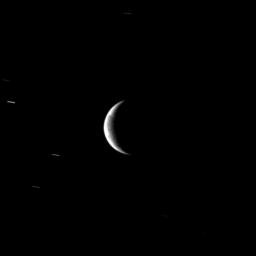
|
Crescent of Changing Terrain
- Click the image above for a larger view
- Full-Res JPEG (513 x 513) (4.5 kB)
- Full-Res TIFF (513 x 513) (263.7 kB)
Caption:
From a distant perspective, the Cassini spacecraft sees hints of the unusual surface of Saturn's moon Enceladus, a moon where new terrain is created around a geologically active south polar region.
See PIA11685 to learn more.
Lit terrain seen here is in the area between the trailing hemisphere and Saturn-facing side of Enceladus (504 kilometers, or 313 miles across). North on Enceladus is up and rotated 3 degrees to the left.
Several background stars are visible elongated by the motion of the spacecraft during the exposure.
The image was taken in visible light with the Cassini spacecraft narrow-angle camera on Dec. 25, 2009. The view was acquired at a distance of approximately 742,000 kilometers (461,000 miles) from Enceladus and at a Sun-Enceladus-spacecraft, or phase, angle of 129 degrees. Image scale is 4 kilometers (2 miles) per pixel.
Background Info:
The Cassini-Huygens mission is a cooperative project of NASA, the European Space Agency and the Italian Space Agency. The Jet Propulsion Laboratory, a division of the California Institute of Technology in Pasadena, manages the mission for NASA's Science Mission Directorate, Washington, D.C. The Cassini orbiter and its two onboard cameras were designed, developed and assembled at JPL. The imaging operations center is based at the Space Science Institute in Boulder, Colo.
For more information about the Cassini-Huygens mission visit http://saturn.jpl.nasa.gov/ . The Cassini imaging team homepage is at http://ciclops.org .
Cataloging Keywords:
| Name | Value | Additional Values |
|---|---|---|
| Target | Enceladus | Saturn |
| System | Saturn | |
| Target Type | Satellite | Planet |
| Mission | Cassini-Huygens | |
| Instrument Host | Cassini Orbiter | |
| Host Type | Orbiter | |
| Instrument | Imaging Science Subsystem (ISS) | |
| Detector | Narrow Angle Camera | |
| Extra Keywords | Grayscale, Rotation, Visual | |
| Acquisition Date | ||
| Release Date | 2010-05-20 | |
| Date in Caption | 2009-12-25 | |
| Image Credit | NASA/JPL/Space Science Institute | |
| Source | photojournal.jpl.nasa.gov/catalog/PIA12637 | |
| Identifier | PIA12637 | |
